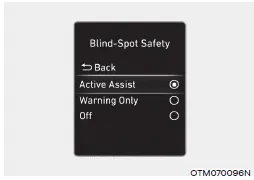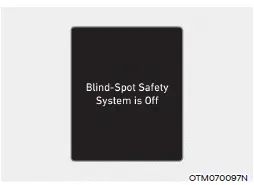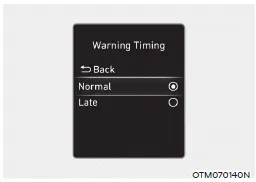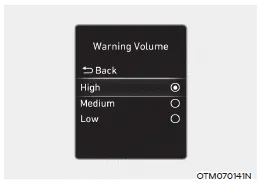Hyundai Elantra (CN7): Blind-Spot Collision-Avoidance Assist (BCA) / Function settings
Setting

Blind-Spot Safety
With the engine on, select or deselect ‘Driver Assistance → Blind-Spot Safety’ from the Settings menu to set whether or not to use each function.
-- If ‘Active Assist’ is selected, the
system will warn the driver with a
warning message, an audible warning
and braking assist will be applied
depending on the collision risk levels.
-- If ‘Warning Only’ is selected, the
system will warn the driver with a
warning message and an audible
warning depending on the collision
risk levels. Braking will not be assisted.
-- If ‘Off’ is selected, the function will
turn off.

When the engine is restarted with the system off, the ‘Blind-Spot Safety System is Off’ message will appear on the cluster.
If you change the setting from ‘Off’ to ‘Active Assist’ or ‘Warning Only’, the warning light on the outside rearview mirror will blink for three seconds.
In addition, if the engine is turned on, when the system is set to ‘Active Assist’ or ‘Warning Only’, the warning light on the outside rearview mirror will blink for three seconds.
WARNING
- If ‘Warning Only’ is selected, braking is not assisted.
- If ‘Off’ is selected, the driver should always be aware of the surroundings and drive safely.
Information
If the engine is restarted, Blind-Spot Safety system will maintain the last setting.
Warning Timing

With the engine on, select ‘Driver Assistance → Warning Timing’ from the Settings menu to change the initial warning activation time for Blind-Spot Safety system.
When the vehicle is first delivered, Warning Timing is set to ‘Normal’. If you change the Warning Timing, the warning time of other Driver Assistance systems may change.
Warning Volume

With the engine on, select ‘Driver Assistance → Warning Volume’ from the Settings menu to change the Warning Volume to ‘High’, ‘Medium’ or ‘Low’ for Blind-Spot Safety system.
If you change the Warning Volume, the warning volume of other Driver Assistance systems may change.
CAUTION
- The setting of the Warning Timing and Warning Volume applies to all functions of the Blind-Spot Safety system.
- Even though ‘Normal’ is selected for Warning Timing, if the vehicles approaches at high speed, the initial warning activation time may seem late.
- Select ‘Late’ for Warning Timing when traffic is light and when driving speed is slow.
Blind-Spot Collision-Avoidance Assist is designed to help detect and monitor approaching vehicles in the driver’s blind spot area and warn the driver of a possible collision with a warning message and audible warning.
Function warning and control Vehicle detection To warn the driver a vehicle is detected, the warning light on the outside rearview mirror will illuminate.
Other information:
Hyundai Elantra (CN7) 2021-2025 Service Manual: Compressor oil
Repair procedures Oil Specification1.The HFC-134a system requires synthetic (PAG) compressor oil whereas the R-12 system requires mineral compressor oil. The two oils must never be mixed.2.Compressor (PAG) oil varies according to compressor model. Be sure to use oil specified for the model of compressor.
Hyundai Elantra (CN7) 2021-2025 Service Manual: Description and operation
D
Categories
- Manuals Home
- Hyundai Elantra Owners Manual
- Hyundai Elantra Service Manual
- Rear Seats
- Components and components location
- Front Bumper
- New on site
- Most important about car
